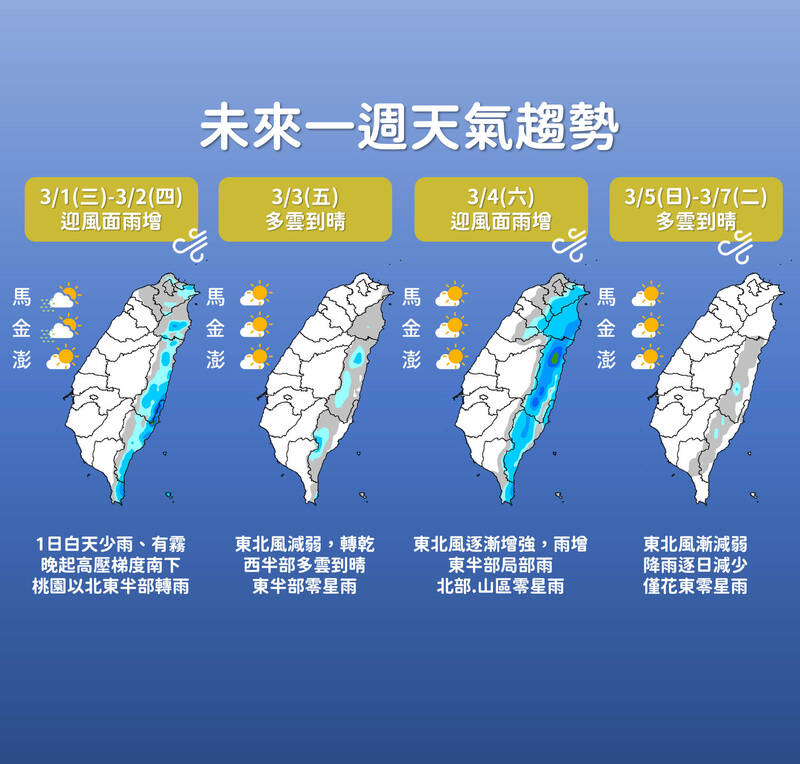The water situation in the south is tight.
The picture shows the rainfall trend for the coming week. The Central Meteorological Bureau predicts that the central and southern regions will be sunny to cloudy with no sign of precipitation in the next 10 days.
(Provided by the Central Weather Bureau)
[Reporter Chen Xinyu/Taipei Report] The south was hit by severe drought. Last year, Kaohsiung Meteorological Station had the lowest rainfall in 24 years, less than 50% of the historical average. Tainan Meteorological Station was the second lowest in 24 years, second only to 2003.
The Central Meteorological Bureau predicts that in the next 10 days, the central and southern parts will be sunny to cloudy and there will be no precipitation signal. Next Monday (6th) will be the 24th solar term Awakening of Insects. It is traditionally believed that after the spring thunder in Awakening of Insects also means more spring rain, but the Meteorological Bureau predicts that in March "Rain less" in the first half of the month.
Meteorological experts also believe that even if spring rains fall in the south in March, it will not help the water situation much, and it may be difficult to get rid of the water shortage in the near future.
According to statistics from the Central Meteorological Bureau, the annual rainfall at Tainan Meteorological Station last year was 1001 mm, and that at Kaohsiung Station was 971 mm, which were only 57% of the annual average (Tainan’s annual average was 1742 mm) and 49% (Kaohsiung’s annual average was 1968 mm). .
Please read on...
Wu Derong, an adjunct associate professor at the Department of Atmospheric Sciences of Central University and former director of the Weather Forecasting Center of the Meteorological Bureau, said that it is impossible to predict when it will rain in the south. We can only say that the central and southern regions are "very scarce, very short of water". Spring will come in March, and everyone may look forward to spring rains However, the amount of rainfall in March and April is not much. Even if the amount of spring rain falling this year is within the normal range, the south will still be in a state of water shortage, because the amount of shortage is accumulated from last year, and the amount of spring rain already accounts for one year. The proportion of the amount of rain is not high, and the rainy season and typhoon are the most rainfall in the south.
According to statistics from the Meteorological Bureau, the rainy season, typhoon and peripheral circulation rainfall from May to September each year account for about 80% to 90% of the annual precipitation in the central and southern regions.
We have to wait for the rainy season to pour in before we can relieve the drought.
Wu Derong said that the weather forecast has its limitations, and it can be predicted that the spring rain will not help much, so artificial regulation is very important. He described "this is Taiwan's fate."
The Bureau of Meteorology's latest weather forecast pointed out that in the first ten days of March, the weather in Taiwan will be gradually warming up and stable, with less rainfall.
March and April gradually enter spring, and there is a chance of localized fog in the western half. The intensity of the cold high pressure on the mainland gradually weakens, and the strength of warm air in the south gradually increases. 1. From May onwards, the rainy season will gradually enter. If the front lingers near Taiwan, it is likely to bring rainfall, and there is a chance of thunderstorms or heavy rains.
It is predicted that the rainfall from March to May will be less than normal, but the probability of less rain will decrease month by month.
Statistics also show the strange phenomenon of "record lows in the south and record highs in the north". Compared with the record lows in the southern stations last year, the northern stations include Danshui, Anbu, Taipei, Keelung, Pengjiayu, Suao and Yilan The precipitation of artificial weather stations in the north and northeast, such as the weather station, was the highest in 10 years last year. As for the Hsinchu Station, it was the second highest in the past 10 years. Zheng Mingdian, director of the Central Meteorological Bureau, explained that it is still within the error value. In particular, a large part of Taiwan's precipitation is due to topographical effects, and it will be uneven. As for the artificial monitoring stations in the north that have set new highs in rainfall in the past 10 years, it is because this winter has been affected by waves of northeast monsoons.
For the weather in the coming week, Liao Jingxiang, a forecaster from the Meteorological Bureau, pointed out that the cold air mass from the mainland will move south tonight, affecting the morning of the day after tomorrow. Northern Taiwan will be cold all day tomorrow, and the central and southern regions will also be cold in the morning and evening. The western half should pay attention to the low temperature of 11 degrees; The second wave of cold air will affect from the daytime of Saturday to next Monday. During this period, the temperature in northern Taiwan will be relatively warm during the daytime, and it will be colder in the morning and evening in various places. The temperature difference between day and night in the central and southern parts will be as large as 12 degrees.
